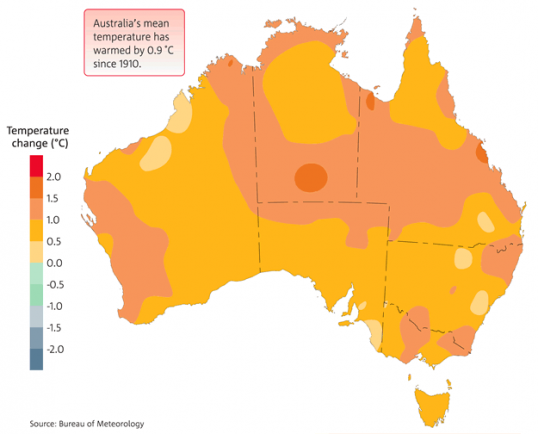This guest post from Mackenzie Fox who lives in Brisbane, Queensland explains the range of challenges facing Australian gardeners as the climate changes:
Gardening and Climate Change in Australia
The Australian continent seems to have been hit harder by emerging climate change than the rest of the world. As the planet gets warmer, there are more weather extremes. Both globally and in Australia, we are facing more floods, droughts, cyclones and bushfires than ever before. With rising temperatures and more frequent heatwaves, already dry Australian soil is getting even drier. According to Australia’s Bureau of Meteorology, the prediction was if 2015 ends with the average November-December temperatures from this century, Australia would see its eighth-warmest year on record.
On the other hand, after periods of prolonged drought, we are experiencing damaging hailstorms, torrential rain and thunderstorm winds. How are our houses and gardens coping with such extreme weather conditions? Heavy downpours and high winds can cause tremendous damage to our homes and surrounding areas. Roofs are being blown away, hundreds of trees are toppling over and properties in coastal areas are being flooded in a blink of an eye.
Climate changes have affected Brisbane, Queensland (this is where I live) as well. It is mostly noticed with sudden weather transitions: extremely hot and humid days may quickly bring the inclement weather with the torrential rains and violent winds. However, Australia is known for its boiling summers and most inner areas (WA, NT, SA) have major issues with droughts and bush fires. Moreover, hot spells last for a number of days with temperatures well over 40°C. On March 19, 2015 the temperature in Birdsville reached 46.5°C that made it the hottest second half of March ever. Considering that the rainfall was 20% below the historical average, this leaves us with lots of worries even when I put my pink glasses on.
In a land of drought, deluge and irregular rainfall, our gardens are not immune either. When trying to create a sustainable garden, things can get even more complex. Greater incidence of extreme weather patterns, such as rising temperatures and reduced rainfall means that we are in for a major challenge and a lot of uncertainty.
Extreme drought already causes serious sunburn in fruits and vegetables, reduced crop yields, as well as earlier ripening and bland tasting produce. Unless we find the way to cope with these changes, we will soon be facing a significantly decreased production of fruits and nuts that will in return have severe economic consequences. To make matters worse, in the foreseeable future our children could be eating flavourless carrots, poor tasting raspberries and rotting potato.
This is why it is essential that gardeners prepare themselves for less predictable and more intense weather events. And above all – to show the capacity to adapt. As the effects of global warming take hold, there are strategies and tips that might help you transform and make the most of your garden. You should reinvent your gardening practices and goals in a way that will allow you to deal with human induced climate change. Put simply, you should make your garden sustainable and future-proof.
When creating a sustainable garden, the most valuable advice you can get is – keep growing your local food even if the way it is grown needs to change. Getting food to your plate directly from your own garden means that you are not only saving money, but you are also actively reducing harmful CO2 emissions. Avoiding chemically processed food and manufacturing, packing and transportation costs (that is, food miles) is the best way to make your personal contribution to a more sustainable future.
Gardening in scorching temperatures might seem like fighting a battle you cannot win, but actually there are many tips and tricks that will prevent your plants from withering in the blazing heat. Any type of rainwater harvesting and water saving methods could come in handy – from installing rain barrels and water bags to watering tubes and drip irrigation.
Another way to fight climate change in your garden is by planting drought tolerant, tough herbs. Oregano, thyme and rosemary are best cultivated in a hot climate and thrive in fairly dry soil. The majority of succulents are also considered to be less thirsty herbs that grow in dry and sunny regions. Aloe Vera, for instance, can withstand a severe lack of water for extended periods of time. By retaining moisture in its fleshy leaves, this succulent plant species tolerates drought quite well.
It may surprise you that, although coping with sandy soil and Australian drought at the same time can be tricky, it is not an impossible thing to do. Because of its weak structure, this type of soil is not able to retain water or nutrients. But you can always opt for growing indigenous plants. These local native species have already been adapted to local weather conditions in a way that allows them a more efficient use of available water in the soil. Lemon myrtle, acacia, eucalyptus and many native Australian shrubs grow just fine in nutrient poor sandy soils.
While growing vegetables in sandy soils is usually challenging, you can always create a raised bed vegetable garden. Enclosed spaces retain water even in super sandy areas, and prevent soil erosion. Raised beds are incredibly handy and great for cultivating small vegetable or flower pots. If done properly, raised bed gardening can also reduce weeds and usually produces higher fruit and vegetable yields.
A good solution to a sandy soil
Using mulch and compost is also a great way of improving your soil and retaining moisture. While compost is made from decomposing food scraps and dead plants, organic mulch is a layer of garden waste that acts as an insulator. Anything from shredded bark to prunings and grass clippings covering the surface of the soil can make a huge difference to your garden. Both materials keep beneficial microorganisms in the soil, add nutrients and maintain water.
In order to avoid scorching summer temperatures, you should start planting in early spring. A variety of spring crops thrives in warm weather. Given the diversity of Australian climate zones, in many regions you can try growing some of the vegetables such as beans, peppers, squash, eggplant, cucumbers, tomatoes, Brussels sprouts, celery, lettuce, cauliflower, onion, broccoli, peas, radishes, spinach, cabbage, turnips, and carrots. If you are a herb lover, consider planting thyme, marjoram, lavender, rosemary, sage, mint, anise, fennel and coriander. In subtropical Queensland you can also plant anything from oregano, sow basil, parsley, sweet potato, watermelon and beetroot to capsicum, kohlrabi, pumpkin, silver beet, okra, sweet corn, sweet potato and zucchini.
And did you know that planting trees is one of the best natural ways to combat climate change? They remove carbon dioxide from the atmosphere, convert and store it as carbon, only to release pure oxygen in the end. And not only that. Trees provide great cooling shade in the summer heat and can considerably reduce stormwater runoff caused by irregular and extreme rainfall. Also, by planting sturdy trees that are less likely to be uprooted in storms, you will prevent soil erosion, a major environmental problem that causes soil degradation.
Eventually, successful adaptation to global warming will require a lot of experimenting and tough decisions. As the seasons get warmer, we might switch to planting varieties with less chill hours needed for a fruit-bearing tree to blossom. So, in the future, even if you have been growing apples and pears for the most of your life, ditching them in favour of low chill citrus fruits might seem a reasonable thing to do.
How all this is going to affect our lives? Not only are we being forced to change our gardening and farming habits – the harshness and unpredictability of the new climate also calls for safer building practices like having specially designed dwellings for cyclonic conditions.
Lastly, as temperatures rise, in the drought-plagued summers to come maybe we should simply let our once-beautiful front lawns turn brown. Sooner or later, lush and well-watered lawns will be considered an act of recklessness affordable by the few.
No matter what, one thing is for certain: climate change is already occurring. How we are going to respond to these changes depends on our ability to accept challenges, deal with risks and stay both flexible and adaptable. Like a wise man once said, The most expensive thing we can do is nothing. And the best way to start the fight is with a change of another kind – the change in our mindset.












Sun, Mar 27, 2016
Climate Change, Australian Climate Change, Guest Blogs